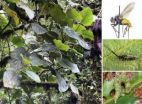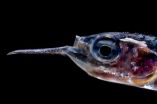(Press-News.org) The total stock of fish on the planet had been reckoned until today to be around 2,000 million tonnes. About half of them were thought to be mesopelagic fish, in other words, ones found at depths of between 200 and 1,000 metres in ocean areas.
However, an international team*, in which AZTI-Tecnalia researchers are participating and which is being led by the doctor in oceanography Xabier Irigoien, has discovered that its abundance could be at least 10 times higher than the original estimate. The results have been published in the journal Nature Communications.
Mesopelagic fish spend the daytime in the twilight zone of the ocean at a depth of between 200 and 1,000 metres and come up to the surface to feed during the night, in what could be regarded as the planet's biggest animal migration. They constitute a significant part of tuna feed, but as they are not fished commercially they continue to be one of the great unknowns.
In this new study, researchers have combined the acoustic data from the Malaspina expedition with a trophic model to conclude that the biomass of these fish must be at least 10 times higher than what had been previously estimated.
As mesopelagic fish feed on the surface and migrate every day to depths of more than 500 metres, they speed up the transport of CO2 to the bottom of the ocean. They also contribute towards increasing oxygen consumption in deep waters. The new biomass estimates indicate that their role in the ocean's biogeochemical cycles needs to be reassessed.
INFORMATION:
The results gathered in the scientific paper have involved researchers from AZTI-Tecnalia, CSIC-Spanish National Research Council, IEO-Spanish Institute of Oceanography, the Universities of Oviedo, Cadiz and Las Palmas de Gran Canaria, together with KAUST (Saudi Arabia), the University of Western Australia and the University of Bergen (Norway).
The Malaspina expedition is a Consolider-Ingenio 2010 project led by Carlos Duarte (CSIC) and funded by the Spanish Ministry for the Economy and Competitiveness. Malaspina comprises 27 research groups from the CSIC, the IEO-Spanish Institute of Oceanography, 16 Spanish universities, one museum, the AZTI-Tecnalia R&D centre and the Spanish Navy. The total funding, which also has the collaboration of the CSIC and the BBVA Foundation as well as of various Spanish universities and AZTI-Tecnalia, amounts to approximately 6 million euros.
(*)Irigoien, X., T. Klevjer, A. Røstad, U. Martinez, G. Boyra, J.L. Acuña, A. Bode, F. Echevarria, J.I. González-Gordillo, S. Hernandez-Leon, S. Agustí, D. Aksnes, C.M. Duarte, and S. Kaartvedt. 2014. Large Mesopelagic Fish Biomass and Trophic Efficiency in the Open Ocean. Nature Communications Nat. Commun. 5:3271 doi: 10.1038/ncomms4271.
The biomass of ocean mesopelagic fish is 10 times higher than estimated
2014-02-07
ELSE PRESS RELEASES FROM THIS DATE:
New plant species a microcosm of biodiversity
2014-02-07
Biologists working in the Andes mountains of Ecuador have described a new plant species, a wild relative of black pepper, that is in itself a mini biodiversity hotspot. The new species, Piper kelleyi, is the sole home of an estimated 40-50 insect species, most of which are entirely dependent on this plant species for survival. This discovery is part of a larger project which focuses on the influence of plant-produced chemical compounds on biodiversity. The study was published in the open access journal PhytoKeys.
The chemical compounds produced by plants are source of ...
Avian flu variant stalks Egypt
2014-02-07
Since its first identification in Asia, highly pathogenic avian influenza—H5N1—has caused significant alarm in the scientific community. While the virus' primary target is birds—tens of millions have already died from it—it is capable of infecting mammals, including humans, causing serious illness and a frightening rate of mortality.
In a new study, Matthew Scotch, a researcher at Arizona State University's Biodesign Institute, tracks the spread of an H5N1 variant in Egypt—a country recently identified as a major epicenter for the virus. In results recently appearing ...
Substance in photosynthesis was at work in ancient, methane-producing microbes
2014-02-07
An international team of researchers led by scientists at Virginia Tech and the University of California, Berkeley has discovered that a process that turns on photosynthesis in plants likely developed on Earth in ancient microbes 2.5 billion years ago, long before oxygen became available.
The research offers new perspective on evolutionary biology, microbiology, and the production of natural gas, and may shed light on climate change, agriculture, and human health.
"By looking at this one mechanism that was not previously studied, we will be able to develop new basic ...
Finding could explain age-related decline in motor function
2014-02-07
SAN ANTONIO (Feb. 6, 2014) — Scientists from the School of Medicine at The University of Texas Health Science Center at San Antonio have found a clue as to why muscles weaken with age. In a study published Feb. 5 in The Journal of Neuroscience, they report the first evidence that "set points" in the nervous system are not inalterably determined during development but instead can be reset with age. They observed a change in set point that resulted in significantly diminished motor function in aging fruit flies.
"The body has a set point for temperature (98.6 degrees), ...
Gender influences symptoms of genetic disorder
2014-02-07
A genetic disorder that affects about 1 in every 2,500 births can cause a bewildering array of clinical problems, including brain tumors, impaired vision, learning disabilities, behavioral problems, heart defects and bone deformities. The symptoms and their severity vary among patients affected by this condition, known as neurofibromatosis type 1 (NF1).
Now, researchers at Washington University School of Medicine in St. Louis have identified a patient's gender as a clear and simple guidepost to help health-care providers anticipate some of the effects of NF1. The scientists ...
The fatality rate among hard drug users is 14 times higher than for the general population
2014-02-07
A new study analyses the risk factors and excess mortality among heroin and cocaine consumers admitted to treatment in Spain. The results reveal that the fatality rate among consumers of both drugs is 14.3 times higher than for the general population, while among those only using cocaine, it is 5.1 times higher.
In Spain the majority of deaths related to cocaine are not correctly certified and therefore up until now very few studies have been carried out that analyse the consequences of consuming these drugs in terms of mortality.
"Death certificates rarely include ...
Smithsonian reports GMO soybean pollen threatens Mexican honey sales
2014-02-07
Mexico is the fourth largest honey producer and fifth largest honey exporter in the world. A Smithsonian researcher and colleagues helped rural farmers in Mexico to quantify the genetically modified organism (GMO) soybean pollen in honey samples rejected for sale in Germany. Their results will appear Feb. 7 in the online journal, Scientific Reports.
David Roubik, senior staff scientist at the Smithsonian Tropical Research Institute, and colleagues developed the ability to identify pollen grains in honey in Panama and in Mexico during the 1980s and 1990s when they studied ...
Fish biomass in the ocean is 10 times higher than estimated
2014-02-07
With a stock estimated at 1,000 million tons so far, mesopelagic fish dominate the total biomass of fish in the ocean. However, a team of researchers with the participation of the Spanish National Research Council (CSIC) has found that their abundance could be at least 10 times higher. The results, published in Nature Communications journal, are based on the acoustic observations conducted during the circumnavigation of the Malaspina Expedition.
Mesopelagic fishes, such as lantern fishes (Myctophidae) and cyclothonids (Gonostomatidae), live in the twilight zone of the ...
'Steak-knife' teeth reveal ecology of oldest land predators
2014-02-07
The first top predators to walk on land were not afraid to bite off more than they could chew, a University of Toronto Mississauga study has found.
Graduate student and lead author Kirstin Brink along with Professor Robert Reisz from U of T Mississauga's Department of Biology suggest that Dimetrodon, a carnivore that walked on land between 298 million and 272 million years ago, was the first terrestrial vertebrate to develop serrated ziphodont teeth.
According to the study published in Nature Communications, ziphodont teeth, with their serrated edges, produced a more-efficient ...
Study reveals record rise in insulin use
2014-02-07
"Understanding the pattern of insulin use is limited by a lack of data characterising the prevalence of insulin use in the UK," according to Craig Currie, Professor of Applied Pharmacoepidemiology at Cardiff University's School of Medicine, who led the study alongside colleagues from the University of Bristol.
"Given the limitations, our study sought to calculate – for the first time – the best possible estimate of the rates of insulin for type 1 and type 2 diabetes."
In this retrospective study the team examined the number of patients receiving prescriptions for ...





